As victories go, this one is the Pyrrhic kind.
For the first time in Streetfilms' ongoing series of bike count videos — which include ground-breaking work on First and Second avenues in Manhattan — the number of cyclists exceeded the number of motorists, the latest evidence that New York City is going to need wider bike lanes to accommodate the ongoing bike boom.
The final count was a razor-thin margin of 235 bikes, e-bikes, scooters and other micro-mobility modes to 234 cars and trucks. That stretch of Kent Avenue near N. Fourth Street, however, sets aside 30.1 feet for the movement and storage of cars and trucks, but roughly 8.6 feet for the movement of cyclists.
So instead of dividing the space evenly, cyclists get 22 percent of the space, while drivers of deadly pollution machines 78 percent of the space — the vast majority of it for vehicles that don't even move most of the day.
Here's the video:
Eckerson said he wasn't surprised by the bike victory. "There are so many cyclists over there that my hunch is if you did a full two-hour count between 5 and 7 p.m., the results would be even more dramatic," he said. "And on a weekend afternoon, too. The number of bikes in Williamsburg on a weekend has reached extraordinary levels!"
Would-be leaders in the neighborhood said they weren't surprised by the Streetfilms count — and some called for action.
"We should expand the width of the Kent Avenue bike lane," said Lincoln Restler, who is running to succeed term-limited Council Member Steve Levin in the district that comprises Kent Avenue.
His rival, Elizabeth Adams, agreed. "Yes, I will push for more space for cyclists on Kent!" she said. "This is an exciting uptick in alternate modes of transit and we need to shift public design toward more creative public space coming out of the pandemic. Now is the time to examine the current lane usage for changes."
April Somboun said she would also demand more space for cyclists and pedestrians/joggers on Kent Avenue "and beyond."
"As someone who does not own a car and my mode of transportation is walking, using a kick scooter, or public transportation such as the subway, it's imperative that we have more and safer bike lanes throughout our district and city," she said. "In turn, this will help us combat climate change and less dependency on cars. I would love to bike with my kids from Brooklyn Heights to Greenpoint to Queens if I felt it was safe to do so."
One candidate specifically said he did not want action at this time.
"That stretch doesn't feel congested or dangerous except for drivers, cyclists, and pedestrians who don't look where they are going," said candidate Ben Solotaire, who is a staffer for Levin. "No one has ever said they wish there was more room for alternative modes, so at this time I don't think I would call for more space for cyclists."
Solotaire added that the city should do bike vs. car counts regularly so whoever is elected can "evaluate every six months."
There's no time for that, said Jon Orcutt — the former DOT official who is not running for anything (except, maybe, Bike Mayor!).
"DOT should revisit the design given the intensive use," said the Bike New York spokesman and dean of the city's cycling advocacy community.
"From bare minimum to more ambitious:
- The surface is terrible and people weaving around in the two-way bike lanes to avoid defects etc makes the crowding feel worse. Bike NY asked for a full resurface in 2019.
- The situation is also made worse by vehicles crowding the bike lane by parking all over the marked buffer areas. DOT needs to get back to pouring concrete islands or at least putting big rocks and concrete blocks in those areas to keep illegal parkers out of the buffers. This maybe a place to get DOT into the bollard business.
- Consider eliminating one of the parking lanes in favor of a much wider bike lane to better accommodate the volume and the speed differentials we experience. We'd also have more room to work with for loading zones etc by reassigning the very low ridership B32 buses over to increasing the frequency of B62 service.
Orcutt added that removing a lane of parking would also allow for wider sidewalks.
"The sidewalk on the west side of the avenue in the core of the North Side is also too narrow so there is a tendency for pedestrians to spill or stand in the bike lane," he said.
The DOT did not immediately return a request for comment filed late on Wednesday.






